Birds are fascinating creatures in all shapes, sizes, and colours. The Grey Heron is one bird that captures the attention of many wildlife enthusiasts. With its majestic appearance and intriguing features, the Grey Heron has a rich history and interesting facts. This blog post will explore everything you need to know about this magnificent bird, including its size, habitat, and classification.
The Grey Heron, scientifically known as Ardea cinerea, has a long and storied history. It is believed to have originated in Africa and later spread to other parts of the world. This bird has been mentioned in ancient texts and folklore, often symbolizing gracefulness and tranquillity. Today, it can be found in multiple regions around the globe, including Europe, Asia, and Africa.
In terms of size, the Grey Heron is a large bird, standing approximately 90 to 100 centimetres tall. Its wingspan can reach 175 to 195 centimetres, allowing it to glide effortlessly through the air. This majestic creature is known for its distinctive grey plumage, long neck, and dagger-like bill. Its slender legs enable it to navigate wetlands and shallow water quickly.
The Grey Heron is primarily found in wetland habitats such as lakes, rivers, marshes, and estuaries. These habitats provide an abundant food source for the bird, mainly consisting of fish, amphibians, and small mammals. With its keen eyesight and sharp beak, the Grey Heron can patiently wait for hours until its prey unknowingly swims into striking distance.
The Grey Heron is a remarkable bird with a captivating history and unique characteristics. Its large size, beautiful plumage, and ability to thrive in wetland habitats make it a creature worth learning about. Whether you are a bird enthusiast or someone who appreciates the wonders of nature, the Grey Heron is an animal name that should not be forgotten. We already have an article on 155+ animals‘ words, so be sure to check it out for more fascinating insights into the world of wildlife.
History of Grey Heron
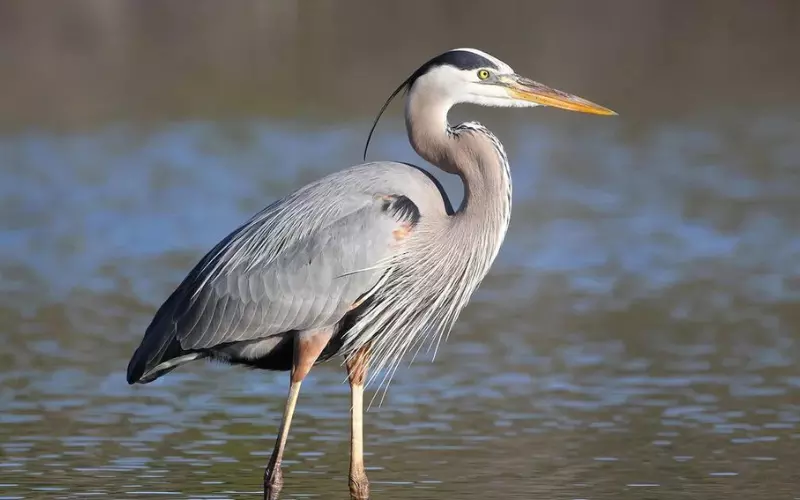
The Grey Heron is a bird that has a fascinating history. These majestic creatures have been around for thousands of years and have been admired by people worldwide. They are found in many countries and habitats, from wetlands to estuaries to coastlines.
In ancient times, the Grey Heron was highly regarded by Egyptians and was associated with the sun god Ra. They believed that the herons were messengers between the gods and the people. The ancient Egyptians even created art showing the heron as a symbol of creation and resurrection. Similarly, in ancient Greece, the heron was considered a sacred bird and was associated with the goddess Athena, who symbolized wisdom and strength.
The Grey Heron has been celebrated for its grace and beauty throughout history. In medieval Europe, the heron was often depicted in artwork and heraldry, symbolizing patience and quiet strength. They were admired for their ability to stand still for long periods, patiently waiting for their prey. In many cultures, the heron is believed to be a symbol of good luck and prosperity.
Today, the Grey Heron continues to captivate people with its elegance and striking appearance. They are known not only for their stunning plumage but also for their incredible fishing skills. These birds can be seen standing motionless by the water’s edge, waiting for the perfect moment to strike and catch their prey. Their long, sharp beaks and sharp eyes make them skilled hunters. Despite facing some threats to their habitats, the Grey Heron remains a resilient and beloved bird cherished by nature enthusiasts around the world.
Importance of Grey Heron

The Grey Heron bird is vital in maintaining a balanced ecosystem. It eats fish, frogs, and other small creatures in rivers and lakes. Doing so helps control these animals’ population, preventing them from becoming too plentiful. This ensures that there is enough food for other species in the water.
The Grey Heron also helps to keep the environment clean. It often drops small pieces of food into the water when it eats. This attracts other animals, such as ducks and smaller birds, who eat these leftovers. In this way, the Grey Heron helps maintain a healthy and thriving wildlife community.
Furthermore, the Grey Heron is considered a beautiful and graceful bird. Many worldwide admire its long neck, stunning feathers, and elegant movements. Its presence adds beauty to our surroundings and reminds us of the incredible diversity of life on Earth.
The Grey Heron plays an essential role in the ecosystem by controlling small animal populations and helping maintain a clean environment. Its beauty also brings joy to those who appreciate nature’s wonders.
Amazing Facts About Grey Heron

1. Grey heron birds are large, wading birds that can grow up to 4 feet tall.
2. They have a wingspan of around 6 feet, which helps them in flight and while hunting for food.
3. These birds sport a grey plumage with a white head and neck, giving them their distinct appearance.
4. Grey herons use long, sharp bills to catch fish, amphibians, small mammals, and insects.
5. They are skilled hunters and use their patient approach to stand motionless in water until prey comes nearby.
6. These birds can often be found near bodies of water such as rivers, lakes, ponds, and marshes.
7. Grey herons are mainly known for their ability to stand very still for long periods, remaining almost invisible to their prey.
8. They also build nests in trees, usually near water, using sticks and branches.
9. These nests can often be seen in colonies, with multiple nests close together.
10. Grey herons lay about 3-6 eggs, and the male and female birds take turns incubating them.
11. The eggs typically hatch after 25 to 29 days.
12. Young grey herons have a more brownish-grey plumage and lack the distinct white head and neck of adults.
13. They usually start flying around 50-60 days old.
14. Grey herons are widespread birds in Europe, Africa, Asia, and Australia.
15. During the breeding season, these birds engage in elaborate courtship displays, including bill-stretching, neck stretching, and wing flapping.
Can we keep a Grey Heron as our Pet?
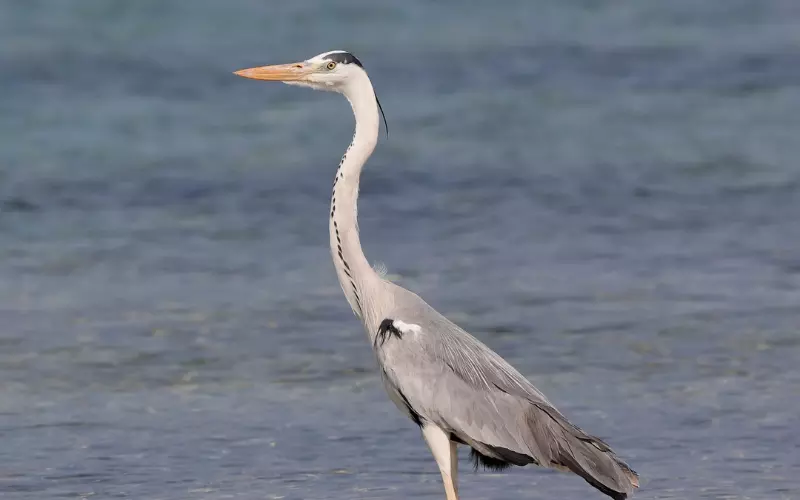
Keeping a Grey Heron bird as a pet is not a good idea. They are wild birds, and keeping them in our homes is inappropriate. The Grey Heron is a beautiful bird, but they must be free to fly, hunt fish, and live in natural habitats.
The Grey Heron bird has not gone extinct. However, it is essential to remember that many bird species are becoming endangered or extinct due to habitat loss, pollution, and poaching. Our responsibility is to protect these birds and their habitats instead of trying to keep them as pets.
If the Grey Heron bird were to go extinct, it would be a significant environmental loss. Extinction means that a species no longer exists in the world. We must work together to prevent this from happening, and one way we can do that is by not trying to keep wild birds like the Grey Heron as pets. Instead, we can enjoy the beauty of these birds by watching them in their natural habitats, where they belong.
It is best not to keep a Grey Heron bird or any other wild bird as a pet. These birds deserve to live freely in their natural habitats, where they can play essential roles in the ecosystem. Let us admire their beauty from afar and do our part to protect them and their habitats, ensuring their survival for future generations.
Size of Grey Heron
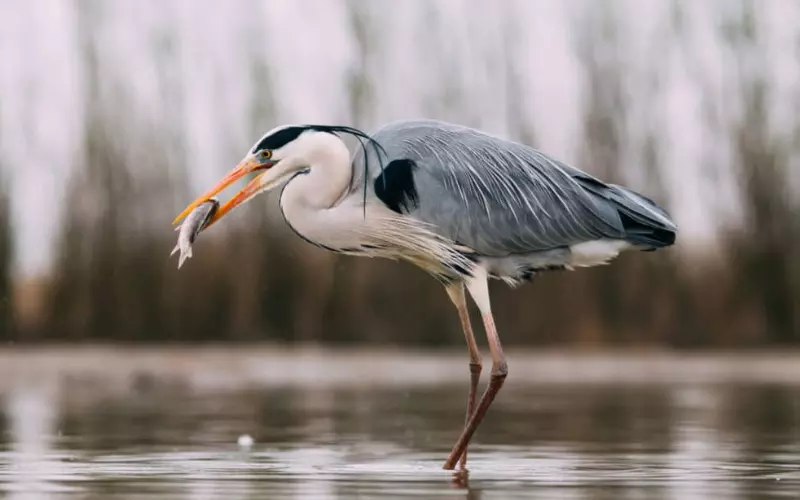
The Grey Heron bird is a majestic creature that can be pretty big. On average, it measures around 90 to 98 centimetres in length, with a wingspan of about 175 to 195 centimetres. This means that the wings of a Grey Heron can stretch out to be about as long as two adult humans standing side by side!
When a Grey Heron is standing, it can reach about 90 to 100 centimetres, making it taller than most kids. Its slender and elongated body allows it to move through the air and water quickly. The heron’s weight can vary, but it’s usually around 1.5 to 2.5 kilograms, roughly like a bag of potatoes.
One exciting thing about the Grey Heron is its long neck. It can be up to 25 centimetres in length! This helps the heron hunt for fish and other small creatures in the water. The Grey Heron can easily catch its prey with its sharp beak and swift movements. It also has long legs, allowing it to wade through shallow water without getting wet.
The Grey Heron bird is large, measuring around 90 to 98 centimetres, with a wingspan of 175 to 195 centimetres. It stands tall at about 90 to 100 centimetres and weighs about 1.5 to 2.5 kilograms. Its long neck, beak, and legs make it a skilled hunter in the water.
Habitat of Grey Heron
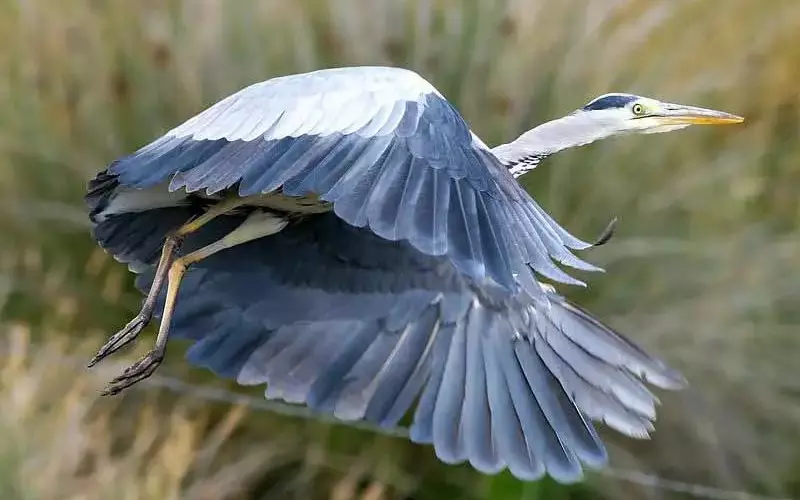
The grey heron bird is found in many different places across the world. They prefer to live near bodies of water, such as rivers, lakes, and marshes. These habitats provide the herons with abundant food and a safe place to build their nests.
One crucial reason why grey herons like water habitats is because they eat fish. They have long legs that help them wade through the water and a sharp beak that they use to catch their prey. The herons are patient hunters, standing very still and waiting for a fish to swim by before quickly striking it with their beaks. In addition to fish, grey herons eat other small creatures like frogs, insects, and even small mammals.
Another reason grey herons like water habitats is that they have a safe place to build their nests. They create large nests of sticks high up in the trees or on tall reeds near the water. This helps protect their eggs and chicks from predators like foxes and other birds. The herons are skilled at building their nests and often return to the same spot year after year to lay their eggs.
Grey herons are fascinating birds that live in habitats near water. They rely on these habitats for food and a safe place to build their nests. We can better appreciate and protect these beautiful birds by understanding their habitat needs.
Evolution of Grey Heron

The Grey Heron bird’s story starts long ago when dinosaurs roamed the Earth. Back then, some creatures looked a bit like herons. They had long beaks and stood on two legs like our Grey Heron today. As time passed, these bird-like creatures changed gradually, evolving into the magnificent birds we know now.
Many years later, during the Ice Age, the world froze, and most animals vanished. But the Grey Heron was different. It could fly, so it went to warmer places for fish to eat. This adaptability helped the Grey Heron survive when others couldn’t.
Over time, the Grey Heron got even better at hunting. It learned to stand still in the water, waiting patiently for fish to swim by. Its long neck and sharp beak allowed it to catch its lunch swiftly. As the years went by, the Grey Heron’s skills improved, becoming even more successful at catching fish.
Today, we can find Grey Herons in many parts of the world, from Europe to Asia. From ancient times until now, they have evolved and adapted to survive. Their story teaches us the importance of being patient and adapting to change. So next time you see a Grey Heron standing still by the water’s edge, remember that its ancestors were similar to dinosaurs, and it’s a living proof of the wonders of evolution.
Classification of Grey Heron

The Grey Heron bird belongs to the Ardeidae family, which includes long-legged wading birds. It falls explicitly under the species Ardea cinerea. This majestic bird can be easily recognized by its long neck, long legs, and greyish feathers. Its scientific name was derived from ancient Greek mythology, where Ardea was the name of a water bird, and cinerea means “ashen grey.”
In terms of physical appearance, the Grey Heron is quite large, typically measuring about 90 to 100 centimetres in height. Its wingspan can reach up to 175 to 195 centimetres, allowing it to soar gracefully across the sky. The plumage of this bird is predominantly grey, except for its head, which has a white face with black markings. During mating season, the adult herons also develop long, elegant feathers on their chest and back.
Grey Herons are versatile birds that can adapt to various habitats. They can be found in wetlands, marshes, lakes, rivers, and nearby coastal areas. As they are skilled hunters, their diet mainly consists of fish, although they also eat small amphibians, reptiles, and insects. With their sharp beaks, they can stab their prey with precision and swallow it whole.
The Grey Heron bird, scientifically known as Ardea cinerea, is a remarkable creature from the Ardeidae family. With its striking appearance and adaptability to diverse environments, this bird is a true wonder of nature. From wetlands to coasts, these herons can be seen gracefully hunting for fish and other small creatures. Their presence adds beauty and grandeur to the natural world.
Different Types of Grey Heron

1. Great Blue Heron: The largest heron with a wingspan of up to 6.6 feet. It is predominantly blue-grey with a distinctive long neck, long legs, and a sharp beak. These majestic birds can be found in wetlands, marshes, and along the shores of rivers and lakes. They feed on a diet of fish, amphibians, and small mammals. Great Blue Herons are skilled hunters and use their sharp beaks to spear their prey.
2. Cocoi Heron: A heron species native to South America. It has a blue-grey plumage with a white crown and a long, pointed, yellow bill. Cocoi Herons are often found in wetlands, marshes, and along rivers. They feed on a diverse diet, including fish, reptiles, insects, frogs, and small mammals. These herons are known for their elaborate courtship displays during breeding season.
3. Grey Heron: One of the most widespread heron species across Europe, Asia, and Africa. It has a predominantly grey plumage, long legs, a long neck, and a dagger-like yellow bill. Grey Herons are skilled fishermen and can be found standing still in shallow waters, waiting for prey to pass by. They primarily feed on fish but consume amphibians, small birds, and rodents. These birds often nest in large colonies in treetops near water bodies.
4. Eastern Great Egret: A large heron found in eastern Asia, Australia, and Europe. It has a white plumage, black legs, and a long, slender neck. Eastern Great Egrets are skilled hunters, standing motionless in shallow waters and quickly striking at fish with their sharp bills. They also feed on crustaceans, insects, amphibians, and small mammals. These herons build their nests in trees, usually in colonies with other waterbirds.
5. Black-headed Heron: A medium-sized heron with a grey body and a black head, neck, and bill. It can be found near water bodies such as lakes, rivers, and wetlands in sub-Saharan Africa. The Black-headed Heron feeds on various prey, including fish, crabs, insects, frogs, small reptiles, and even small mammals. It is known for its loud, raucous calls and is a solitary bird outside the breeding season. These herons build their nests in trees using sticks and other materials.
6. White-faced Heron: A small heron with a greyish-blue body and a white face, neck, and breasts. Native to Australia, New Zealand, and parts of Indonesia. White-faced Herons feed on a diet of fish, crustaceans, insects, amphibians, and small reptiles. They are often seen in coastal areas, wetlands, riversides, and urban parks. These herons are known for their patience when hunting, usually standing completely still for long periods.
7. Indian Pond Heron: A small heron found in the Indian subcontinent and Southeast Asia. It has a grey-brown plumage, a white chin, and a long, tapered beak. Indian Pond Herons prefer lagoons, ponds, and marshes as their habitat. They feed on prey, including small fish, insects, crustaceans, amphibians, and even small snakes. These herons are often seen hunched when hunting, blending in with the surrounding vegetation.
8. Chinese Pond Heron: A small heron species native to eastern Asia. It has a grey-blue plumage during the breeding season and turns mostly white during the non-breeding season. Chinese Pond Herons are skilled hunters, often seen stalking their prey in shallow waters. They primarily feed on fish, frogs, insects, and crustaceans. These herons are known for their ability to rapidly change their appearance and mimic plants by swaying back and forth.
9. Pacific Reef Heron: A medium-sized heron found in the Pacific and Indian Oceans. It comes in two colour morphs: dark morph (grey) and light morph (white). Pacific Reef Herons are specialized hunters, catching prey in the water and on land. They feed on various organisms, including fish, crabs, insects, and small seabirds. These herons build their nests in trees or rocky cliffs, often close to the water.
10. Black-crowned Night Heron: A medium-sized heron with a black crown, grey wings, and red eyes. It can be found in North and South America, Europe, Asia, and Africa. Black-crowned Night Herons are nocturnal birds, feeding primarily during the night. They eat a diverse diet that includes fish, crustaceans, insects, amphibians, reptiles, and small mammals. These herons build their nests in trees near water bodies and are known for their loud, croaking calls.
Geographical Presence of Grey Heron

The Grey Heron bird is found in many different regions around the world. This majestic bird can be seen in Europe, Asia, Africa, and North America. It is a versatile bird that can adapt to various habitats, such as wetlands, rivers, lakes, and coastal areas. With its long legs, sharp beak, and striking appearance, the Grey Heron is a remarkable sight for nature enthusiasts in these regions.
However, there are some places where the Grey Heron bird is not found. One such region is the Americas, excluding a small area in the southeastern part of the United States. This means countries like Canada, Brazil, and Mexico do not have the Grey Heron as a native bird species. Similarly, the bird is not found in Australia or Antarctica. These regions have different environmental conditions that may not be suitable for the Grey Heron’s survival or migration.
The Grey Heron bird is found in various regions across Europe, Asia, Africa, and North America. Its adaptable nature allows it to thrive in different habitats, such as wetlands, rivers, lakes, and coastal areas. However, it is not found in the Americas (excluding a small area in the southeastern United States), Australia, or Antarctica. These regions have different environmental conditions where the Grey Heron cannot be seen.
Scientific Name of Grey Heron
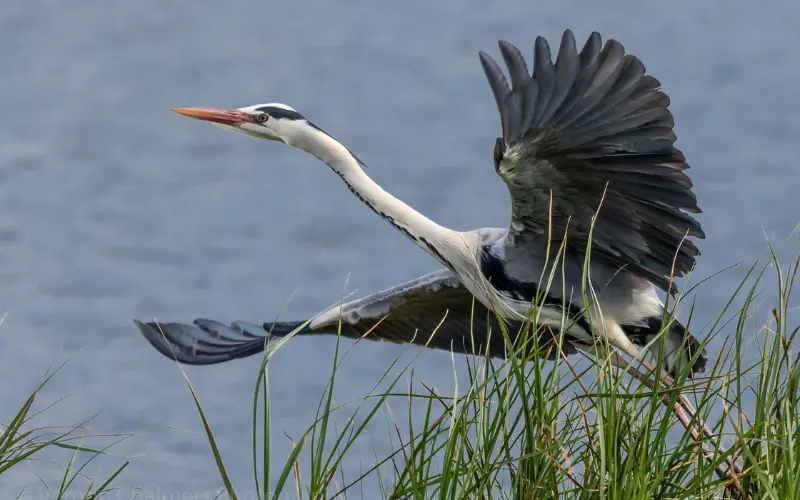
The scientific name of the Grey Heron bird is Ardea cinerea. This name helps scientists identify and classify different species of animals. It is also known as the Gray Heron or the Common Heron. This majestic bird is found in many parts of the world, including Europe, Asia, and Africa.
The Grey Heron is a tall, slender bird with long legs and neck. It has beautiful grey feathers on its body, with white feathers on its head and neck. Its wingspan can reach up to 6 feet, making it an impressive sight when it takes flight.
These birds are usually found near bodies of water, such as rivers, lakes, or wetlands. They are excellent hunters and feed on small fish, amphibians, insects, and even mammals. The Grey Heron uses its sharp beak to catch its prey, often standing still in the water or patiently waiting for an opportunity to strike.
The scientific name of the Grey Heron bird is Ardea cinerea. This magnificent bird is known for its grace and beauty and can be found near water bodies in many parts of the world. It is a skilled hunter and relies on its beak to catch fish, insects, and other small creatures.
Diet of Grey Heron

The Grey Heron bird has an exciting diet. It mainly eats fish but enjoys feasting on frogs, small mammals, and other birds! This bird is a skilled hunter with a long neck that helps it catch its food. When it spots a fish swimming in the water, the Grey Heron quickly strikes, using its sharp beak to snatch the fish out of the water precisely.
But that’s not all the Grey Heron eats! It also loves munching frogs, which it catches by standing still near the water’s edge. When a frog hops by, the Grey Heron swiftly snatches it up with its beak. Sometimes, this bird will even eat small mammals like mice or voles, which it finds in grassy areas near water bodies.
In addition to fish, frogs, and small mammals, the Grey Heron also has a taste for other birds. It may snatch smaller birds like ducklings or even catch adult birds. It becomes a fierce predator when it comes across other birds and won’t miss the chance to have a birdy feast. The Grey Heron’s diverse diet helps it survive and stay healthy.
Overall, the Grey Heron bird is not picky regarding its food. It will eat fish, frogs, small mammals, and other birds. This bird is a skilled hunter with its long neck and sharp beak. The Grey Heron’s ability to adapt its diet is one of the reasons why it is such a successful and fascinating bird.
Locomotion of Grey Heron

The way a Grey Heron bird moves is quite fascinating. It has long legs and a long neck, which helps it to walk gracefully through the water and marshes where it lives. When it walks, it takes slow and deliberate steps, lifting one leg at a time. This helps the bird keep its balance and move with precision.
When a Grey Heron wants to catch fish, it stands still in shallow water and waits patiently. Suddenly, it strikes lightning fast with its long beak, catching its prey incredibly fast. The bird’s wings are also crucial for its locomotion. It stretches its impressive wingspan and takes off into the sky when it wants to fly. The Grey Heron can soar high above trees and waters, using its wings to glide effortlessly.
The Grey Heron moves gracefully on land, lifting its legs one at a time. It strikes quickly when hunting, using its long beak to catch fish. And when it wants to explore the skies, it spreads its wings and soars above us all.
Social and Sexual Behaviour of Grey Heron
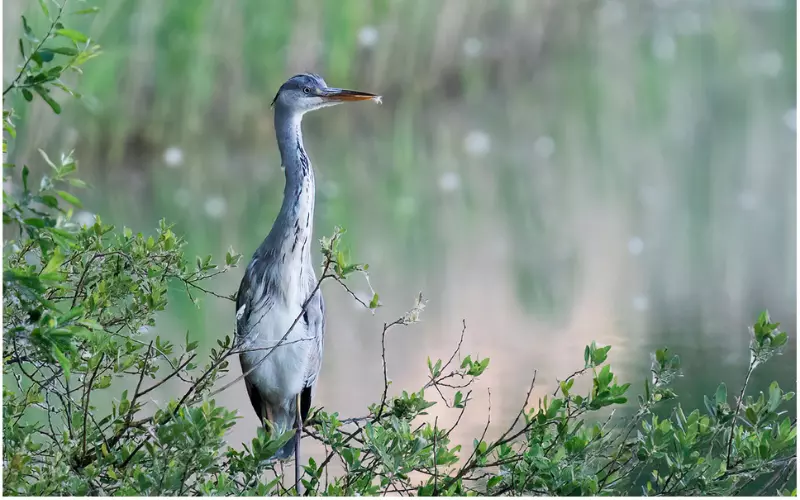
The grey heron bird has interesting social and sexual behaviours. They often gather in groups called colonies, building their nests in trees or reed beds near water. These colonies can sometimes consist of hundreds of heron pairs! Within these colonies, the herons exhibit a hierarchy, with dominant individuals having better access to resources such as nesting sites and food.
Regarding reproduction, the grey heron follows a monogamous mating system. This means that a male and a female form a pair bond and stay together for the breeding season. They take turns incubating the eggs and raising the chicks. The courtship rituals of the herons involve elaborate displays, such as flapping their wings and stretching their necks. These behaviours help to establish and strengthen the pair’s bond.
Interestingly, grey herons also engage in occasional extra-pair copulations. This means that although they form a pair bond, they may mate with others outside their pair. This behaviour can increase the offspring’s genetic diversity, ensuring better survival chances. Overall, the social and sexual behaviours of the grey heron bird provide an exciting glimpse into their fascinating lives.
Reproduction and Lifecycle of Grey Heron
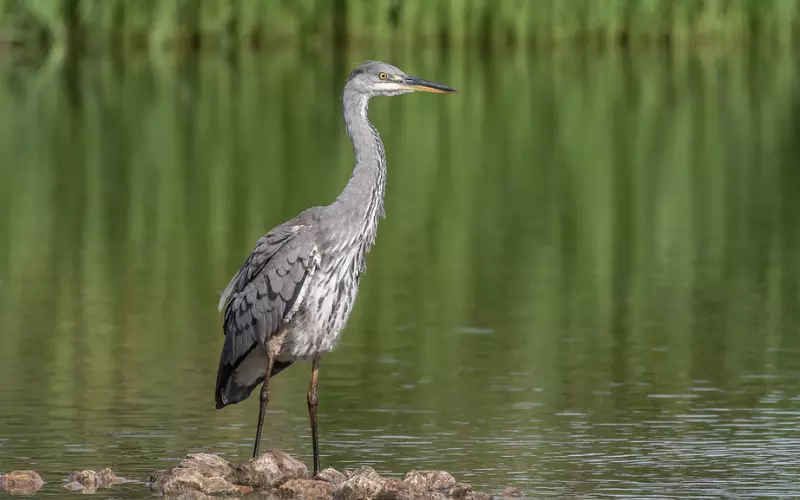
The Grey Heron is a beautiful bird that has an interesting life cycle. It starts with the process of reproduction. Male and female herons find each other during the breeding season. They engage in a courtship ritual involving posturing and calling to one another. Once they have found a suitable partner, they build a nest together.
The female heron lays eggs in the nest, usually around three to five eggs. The male and female take turns keeping the eggs warm, a process known as incubation. This helps to ensure that the eggs develop correctly. After about 25 to 30 days, the eggs hatch, and the baby herons, known as chicks, emerge.
The parents take turns feeding and caring for the chicks. They regurgitate food, such as fish and small amphibians, into the mouths of the hungry youngsters. As the chicks grow, their parents gradually introduce them to hunting and foraging skills. This allows them to become independent over time.
As the young herons grow more robust and self-sufficient, they explore their surroundings. Eventually, they will leave the nest and venture out on their own. They may migrate to new areas in search of food and suitable habitat. This starts the life cycle, as they will find a partner and begin the reproduction process.
The Grey Heron’s life cycle begins with courtship and nest-building. The eggs are then laid and incubated until they hatch. The parents care for the chicks until they become independent, and eventually, the young herons leave the nest to start their life cycle.
Threats to Grey Heron

Grey heron birds are fascinating creatures that inhabit wetlands and marshy areas. Unfortunately, they face several threats that endanger their population and existence. One of the significant threats to these birds is habitat loss. Wetland areas are being destroyed or altered due to human activities such as urbanization, agriculture, and industrialization. This habitat loss disrupts the heron’s natural nesting and feeding grounds, forcing them to search for alternatives or compete with other species for limited resources.
Another threat to grey herons is pollution. Wetlands are prone to corrosion from various sources, including chemicals, pesticides, and oil spills. These pollutants harm the birds’ health, contaminating the water and fish the herons feed on. Consuming contaminated prey can lead to serious health issues, affecting the herons’ reproductive success, growth, and overall survival.
Additionally, the disturbance caused by humans also poses a threat to grey herons. Human activities such as recreational boating, fishing, and tourism can disrupt the peaceful environment herons require for nesting and foraging. Constant disturbance can cause stress and anxiety for the birds, leading them to abandon their nests and eggs. Trouble can also make it harder for the herons to find food, resulting in malnutrition and weakened immune systems.
Grey heron birds face various threats that put their population at risk. Habitat loss, pollution, and human disturbance all contribute to these birds’ challenges in their natural habitat. It is essential to raise awareness about these threats and take necessary measures to protect and conserve the wetland ecosystems where grey herons reside. This way, we can ensure the survival of these magnificent birds and maintain the balance of our natural environment.
The population of Grey Heron
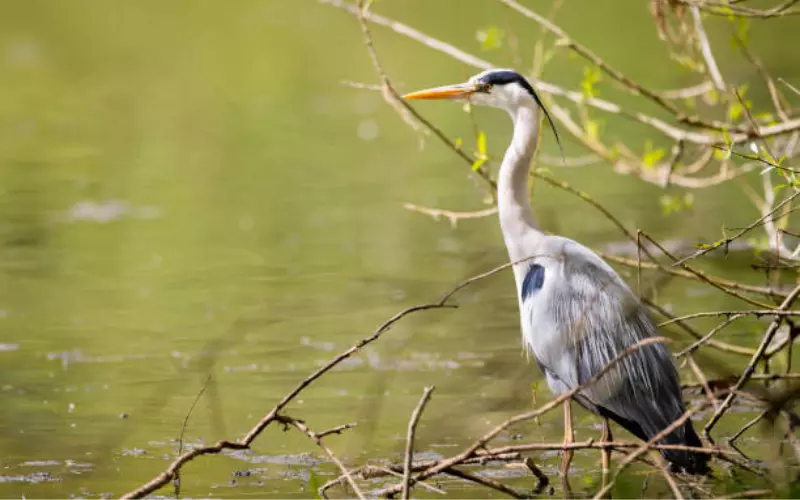
The population of the grey heron bird, a majestic species found across Europe and Asia, is estimated to be around 2 million individuals worldwide. These graceful birds are known for their long legs, slender necks, and distinctive grey plumage. They primarily inhabit wetland areas, such as lakes, rivers, and marshes, where they feed on fish, amphibians, and small mammals.
If, unfortunately, the grey heron were to become extinct, it would significantly lose our planet’s biodiversity. Extinction means that a species no longer exists, and this can happen due to various reasons, such as habitat destruction, pollution, or overhunting. Extinctions disrupt the balance of nature and can have far-reaching consequences, affecting other species and entire ecosystems.
To prevent such a tragic event, humans need to be aware of our impact on the environment and take steps to protect the habitats of these magnificent birds. Conservation efforts, such as creating protected areas and raising awareness about the importance of preserving biodiversity, can help ensure the survival of the grey heron and many other species that contribute to the beauty and richness of our natural world.
Conclusion
The Grey Heron is a fascinating bird known for its history, facts, size, habitat, and classification. This majestic creature has a long and rich history, depicted in ancient Egyptian and Greek art. Its large size, with a wingspan of up to six feet, makes it an awe-inspiring sight in the wild.
Regarding habitat, the Grey Heron can be found in various environments, such as wetlands, rivers, lakes, and even urban areas. They are skilled hunters, waiting patiently by the water’s edge to catch fish, frogs, and small mammals. Their long beaks and necks aid in their successful fishing endeavours.
Regarding classification, the Grey Heron belongs to the family Ardeidae and the species Ardea cinerea. It is classified as a wading bird, known for its ability to wade through shallow waters for food. Its distinctive grey plumage and striking appearance make it a recognizable bird in the animal kingdom.
The Grey Heron is a remarkable bird with a long history, interesting facts, and a unique place in its habitat. Its size, habitat, and classification make it an essential member of the animal kingdom. Observing a Grey Heron in its natural habitat is a true delight, showcasing the beauty and diversity of our natural world.
Frequently Asked Questions about Grey Heron (FAQ’s)
What is the scientific name of the Grey Heron bird?
The scientific name of the Grey Heron bird is Ardea cinerea.
How big is the Grey Heron bird?
The Grey Heron bird can reach a height of up to 100 centimetres and have a wingspan of about 175 centimetres.
What is the natural habitat of the Grey Heron bird?
Grey Herons are commonly found in wetland areas such as marshes, lakes, and rivers across Europe, Asia, and Africa.
What does a Grey Heron bird eat?
The Grey Heron primarily feeds on fish but also consumes amphibians, small mammals, birds, and insects.
How does the Grey Heron hunt for food?
Grey Herons typically stand still or move slowly in shallow water, waiting for fish or prey to come close and quickly strike with their sharp bills.
Do Grey Herons migrate?
Yes, Grey Herons migrate during the colder months to seek better feeding opportunities and escape freezing temperatures.
How long do Grey Herons live?
In the wild, Grey Herons have an average lifespan of 5 to 6 years, but they can live up to 25 years in captivity.
Are Grey Herons solitary birds?
Although Grey Herons are generally solitary birds, they tend to gather and nest in colonies, especially during the breeding season.
When do Grey Herons breed?
Grey Herons typically breed during the spring season, from March to May.
How many eggs does a Grey Heron lay in a clutch?
A Grey Heron usually lays 3 to 5 pale blue eggs in its nest.
How long does it take for Grey Heron eggs to hatch?
The eggs of Grey Herons typically take around 25 to 26 days to hatch.
Do Grey Herons build nests?
Yes, Grey Herons build large nests made of sticks and twigs in trees, reed beds, or sometimes on the ground.
What are the predators of the Grey Heron bird?
Predators of Grey Herons include large birds of prey like eagles and owls, as well as mammals like foxes and raccoons.
Are Grey Herons endangered species?
Grey Herons are not considered endangered. Their populations are stable and listed as a species of “least concern” by the International Union for Conservation of Nature (IUCN).
Can Grey Heron birds fly?
Yes, Grey Heron birds are excellent fliers. They have potent wings that allow them to fly long distances and reach high altitudes.

Hey there, I’m Kristen Haudenschild! I’m like a superhero for animals and people.
I work as a Dependable Hard Working Supervisor, which means I help both people and animals grow and learn. I did my school at OdySea Aquarium and Georgia Southern University in Tempe, Arizona. That’s where I learned all about animals, and guess what? I’m fascinated by them!
I even write cool articles about animals. My job history includes being an Animal Trainer and a Marine Mammal Trainer II at OdySea Aquarium. I’ve also been a Senior Animal Care Specialist and an Animal Care Specialist 2.
I love exploring animals and am always ready to help others learn more about them. So, if you ever need info about animals, give me a shout!












